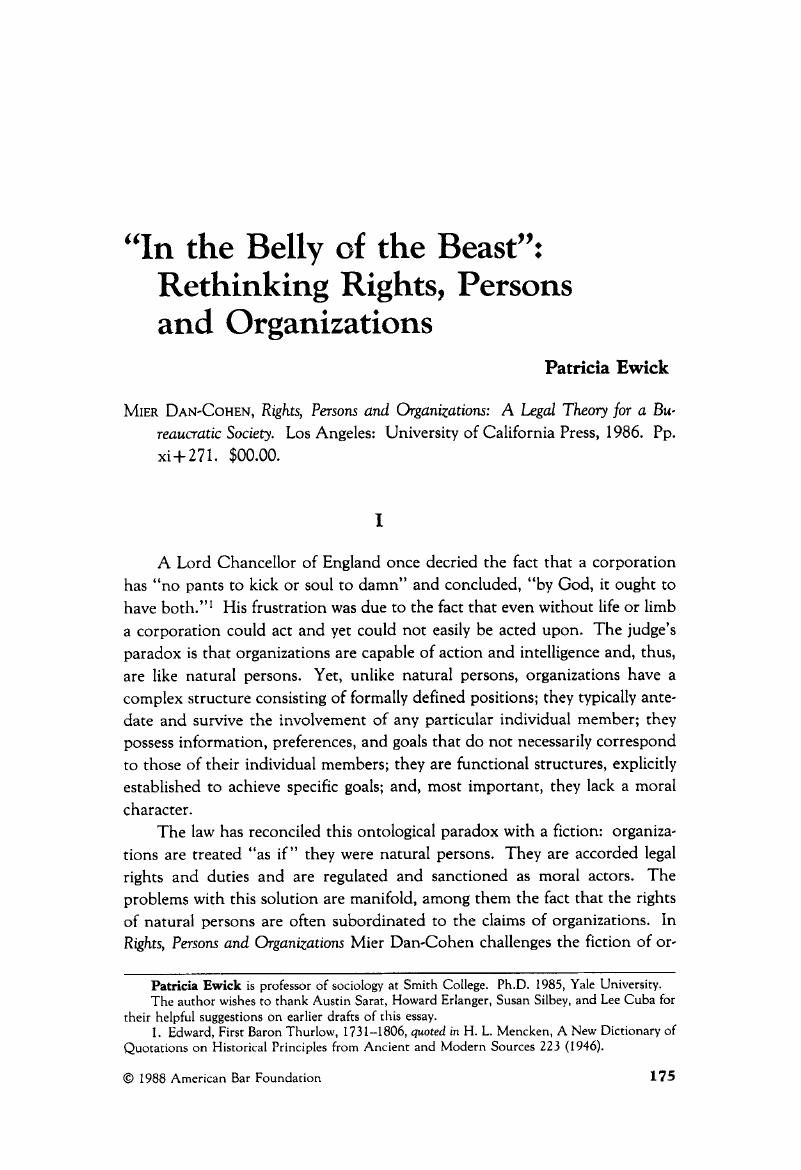Published online by Cambridge University Press: 27 December 2018

1 Edward, , First Baron Thurlow, 1731–1806, quoted in Mencken, H. L., A New Dictionary of Quotations on Historical Principles from Ancient and Modern Sources 223 (1946).Google Scholar
2 407 U.S. 551 (1972).Google Scholar
3 Karl Klare has written on the varied connotations of the “public-private distinction.”“[It] is used to refer to the difference between ‘open’ and ‘intimate’-the key issue being ‘privacy.’ A second connotation is the difference between the world of work and government and the world of social life and family. …‘Public/private’ is also used to distinguish that which affects and concerns others and that which is ‘personal.’… The most important usage in labor law, and in the liberal political tradition generally, has to do with the distinction between the state and civil society.” Klare, The Public/Private Distinction in Labor Law, 130 U. Pa. L. Rev. 1358 (1982). Although Dan-Cohen rejects the public/private distinction in discriminating between the state and civil society (ie., public and private organizations), he retains the other distinctions.Google Scholar
4 Emile Durkheim, The Rules of the Sociological Method (New York: Free Press, 1964).Google Scholar
5 Dennis Wrong, , The Oversocialized Conception of Man in Modern Society, 26 Am. SOC. Rev. 183 (1961).CrossRefGoogle Scholar
6 Gerald Frug, , The Ideology of Bureaucracy in American Law, 97 Harv. L. Rev. 1276, 1291 (1984).CrossRefGoogle Scholar
7 Erving Goffman, Role Distance, [n Encounters (Indianapolis: Bobbs-Merrill Co., 1963).Google Scholar
8 Id. at 152.Google Scholar
9 A related problem with Dan-Cohen's metaphor of the depersonalized organization is his focus on large, bureaucratic profit-making organizations such as IBM, GM, and ATGrT. Because organizations are marked hy immense variation in size, structure, goals, and lifespan, building an organizational jurisprudence using such examples distorts his analysis and limits its usefulness. Although Dan-Cohen admits that there is a conceptual continuum with organizations at one end and individuals at the other and that any particular organization may “inhabit the continuum,” he fails to describe that continuum. In fact, since he has described ideal types as his end points, all organizations (with exception of his mythical personless corporation) inhabit the continuum. Given this fact, more attention needs to be paid to distinguishing among organizations, analytically relating their structural and operational attributes to their moral status.Google Scholar
10 Laura Shill Schrager, , & James Short, , Toward a Sociology of Organizational Crime, 25 SOC. Probs. 405 (1975).Google Scholar
11 Kai T. Erikson, Everything in Its Path: The Destruction of Community at Buffalo Creek (New York: Simon & Schuster, 1976).Google Scholar
12 Mark Tushnet, . An Essay on Rights, 62 Tex. L. Rev. 1363 (1984).Google Scholar
13 Id. at 1363.Google Scholar
14 Hannah Arendt, On Revolution 114–15 (New York: Viking Press, 1962).Google Scholar
15 James Coleman argues that the recognition of natural rights and rhe emergence of the modern corporation at the end of the Middle Ages were historically and funcrionally related. “As rhe social organism slowly broke down, as rhe king or the stare gained in power and as individuals gained in power, becoming free persons rather than the smallest unit in the social organism, a new set of intermediary entities emerged between the individual and the stare, filling the power void slowly being created. Natural persons needed vehicles through which they could express and use their new-found power. The result was the modern corporation.”James Coleman, Power and the Structure of Society 27 (New York: W. W. Norton, 1974).Google Scholar
16 Schrager & Short, 25 Soc. Probs. (cited in note 10).Google Scholar
17 Frug. 97 Harv. L. Rev. (cited in note 6).Google Scholar
18 Coleman, Power and the Structure of Society (cited in note 15).Google Scholar
19 Frug, 97 Harv. L. Rev. 1292.Google Scholar